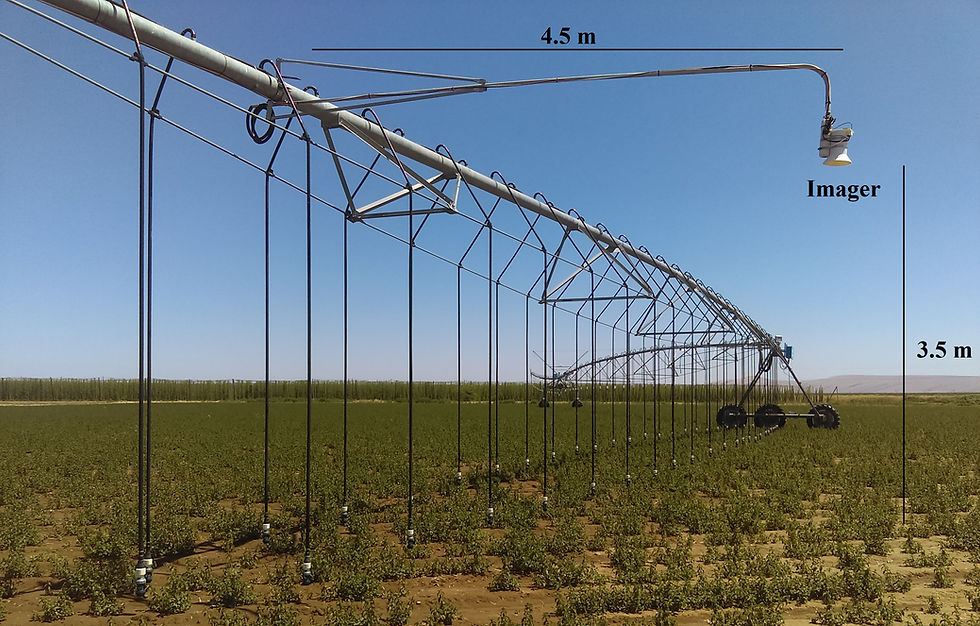Thermal Imagery vs. Infrared Thermometry
Canopy temperature combined with some ancillary measurements can be used for detecting plant biotic/abiotic stress, yield estimation, etc. Surface temperature measurements can be carried out using either thermal imagers or infrared thermal (IRT) radiometers. The limitations of thermal sensors and recent advancements leading to less expensive, high-resolution thermal imagers have encouraged researchers to find a wide range of applications for thermal imagery in agriculture. However, complicated image processing requirements and unavailability of commercial imagers suitable for continuous field measurements remain challenging. Thus, the prevalent method for the measurement of plant canopy surface temperature is still infrared thermometry using IRT sensors.
Challenges of Thermal Imaging
Researchers have always preferred to use thermal imagers instead; however, a simple literature review will reveal that there are no cases of using thermal imagers for continuous canopy measurements, and all related studies are limited to occasional field or greenhouse measurements. Commercial thermal imagers are mainly manufactured for applications in the security business or industrial machine vision applications and therefore not intended for unattended field applications in agriculture. Another issue is that majority of people in the agricultural research community are not familiar with image processing basics and do not know how to extract useful data from thermal images.
Potential Applications of Thermal Imagery
Fruit surface wetness and temperature are important parameters in fruit loss management during pre- and post-harvest produce handling and management. An economical thermal imaging system can have a wide range of applications in plant and fruit stressors monitoring during production. Many applications for such system can be found in two recently published review papers on applications of thermal sensing (Khanal et al., 2017) and recent advances in crop water stress detection (Ihuoma et al., 2017). For example, it can be used for
tree-fruit frost monitoring for effective actuation of management methods,
prevention of fruit heat damage (i.e. sunburn)
fruit surface characteristics (temperature, wetness, abiotic/biotic stressors) monitoring (e.g. prevention of fruit cracking),
crop and fruit pest and disease monitoring and prediction,
crop transpiration and water stress monitoring,
fruit (e.g. pear) surface temperature monitoring in storage rooms, and
high throughput phenotyping (HTP).
Fruits, such as apples and sweet cherries, are sensitive to extreme environmental temperature. Fruit may be injured when their surface temperature is lower (cold injury) or higher (sunburn) than threshold values in given conditions (humidity, wind velocity, etc.). To prevent temperature induced fruit injury, management strategies include canopy spray of water or ventilation with wind machine. However, current operational decision making heavily relies on the data from open field weather stations, which are not able to accurately measure the canopy temperature of tree canopies, especially in the locations near fruits. For example, apple growers in Washington State have no means for monitoring the actual surface temperature of their apples. They, instead, rely on predictions of this parameter provided by a local weather network. If the temperature reached a critical point, they would activate their overhead sprinklers. These predictions, however, have shown not to be reliable. False signals result in a waste of precious water, which is becoming increasingly scarce due to drought in the region. An imaging system can be mounted beside or in fruit bunch to mimic the real condition and provide better decision making for prevention of fruit injury due to extreme temperature.
Bacterial and fungi related diseases are one of the biggest challenges in high density fruit crops, such as grapes. Previous evidences have shown that bacteria and fungi are closely related to the humidity and wetness of fruit and canopy. Disease affected fruit surface humidity and temperature may be different from that of healthy fruits. Quantification of fruit surface wetness and temperature will provide a promising way for monitoring and prediction of fruit disease.
Some varieties of fresh-market fruit, such as sweet cherry, tomatoes or grapes are sensitive to fruit surface wetness level, which may lead to serious fruit cracking and loss of fresh-market values. For example, sweet cherry faces the challenge of crop loss up to 90% in some varieties due to fruit splitting/cracking from rains prior to harvest. One of assumptions on the rain-induced fruit cracking is the excessive intake of rainwater retaining on fruit surface after rainfall events, especially in the locations of bowl or stem-end, which results in the most important two types of fruit cracking: bowl (stem-end) and tip (apical-end) cracking. Currently, there is no method to quantify the amount of water (wetness level) in those areas. By utilizing an imaging system, fruit cracking mechanism may be fully understood, and decision aid tools may be developed for efficient rainwater removing to prevent fruit cracking.
Development of Thermal Imaging System for Center Pivot

To help the agricultural community, our team at Washington State University developed an affordable thermal-RGB imaging system for monitoring water status, health and coverage of crops (Osroosh et al, 2018). The imager can communicate with a microclimate unit wirelessly, and pull, display and log the data. The system can be used for continuous monitoring in the field at a fixed position or aboard moving irrigation systems (e.g. center pivot irrigation machines). The imager can be used to create a wireless network for high resolution spatial and temporal monitoring of agricultural fields and orchards. The current design of the imager allows for creating a star network of imaging units in the field to obtain real-time surface temperature data from plant canopies.
Learn more about the imaging system in this post.
Citation
Ihuoma, S.O., Madramootoo, C.A., 2017. Recent advances in crop water stress detection. Comput. Electron. Agr., 141: 267–275.
Khanal, S., Fulton, J., Shearer, S., 2017. An overview of current and potential applications of thermal remote sensing in precision agriculture. Comput. Electron. Agr., 139: 22–32.
Osroosh, Y. et al., 2019. Detecting fruit surface wetness using a custom-built low-resolution thermal-RGB imager. Computers and Electronics in Agriculture, 157: 509-517.
Osroosh, Y. et al., 2018. Economical thermal-RGB imaging system for monitoring agricultural crops. Computers and Electronics in Agriculture, 147: 34–43.

Comments